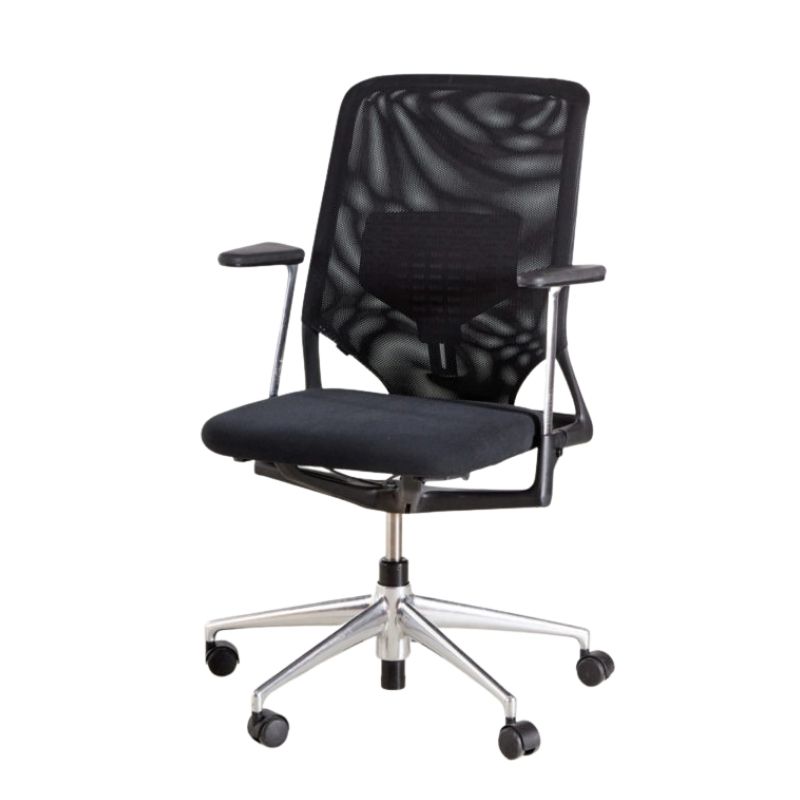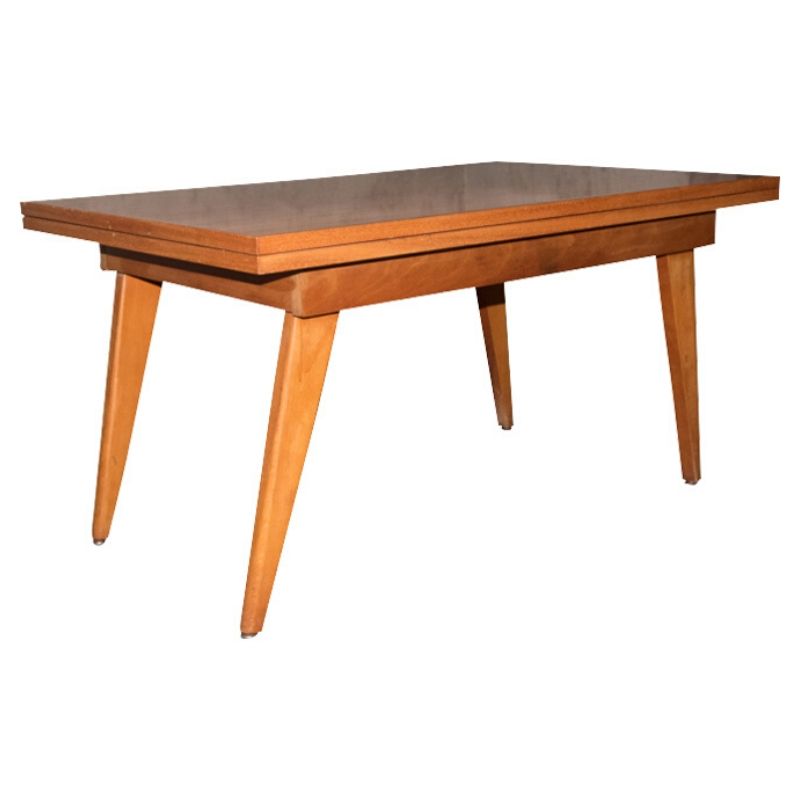I recently picked up an older Nakashima straight-back chair for Knoll. However, someone decided it was a good idea to use COPIOUS amounts of yellow wood glue to reglue all the back spindles in, top and bottom. I would like to take the chair apart and put it back together correctly. Anyone have any ideas that work for removing or loosening wood glue enough to get this thing apart?
Nope
Yellow glue dries almost rock hard. It can be destroyed with heat -- but you'd have to reduce the joints to charcoal before the glue gave up. I've never heard of any chemical that would dissolve it.
Are the spindles correctly positioned ? If so, I'd recommend carving away the excess glue, and calling it done. Cutting (with a modelmaker's saw ?) and careful paring with sharp tools would be the technique.
Sorry about that. . . We always say "you get one chance" when gluing -- it's sort of like firing a piece of ceramic, in that sense.
I've seen someone do this on...
I've seen someone do this on a chair too, foamed polyurethane glue that just went everywhere.
I agree, use a chisel, a stanley knife blade or a scalpel, whatever is easiest to use. Once you get started you'll be suprised how quickly you'll get through it.
.
I disagree, not on such a good chair, even if you have to get stuck into it with sand paper or a very small fine file and refinish the whole thing.
His daughter seems a very responisible caretaker,
"Using George Nakashima Woodworker's certified repair and refinishing service assures that your piece will be restored properly and will maintain its value for years to come. Repairs are preformed by our highly trained craftsmen who follow our traditional finishing process. During restoration, parts will be replaced exactly as per the original unless structural revisions are necessary.
A restoration estimate can be done by e-mail or phone. However, a final assessment is needed once the piece arrives. At that time, our craftsmen will evaluate the refinishing and/or repair and discuss the possible solutions.
Upon completion of your certified repair, you will be sent a certificate of authenticity signed by Mira. For an additional fee, we can also provide you with a copy of the original order and current replacement value of your piece.
We will be happy to manage all shipping arrangements."
http://www.nakashimawoodworker.com/repairs
It's a challenge to glue something, without mucking it up,
for amateurs like myself. And, I've certainly dealt with my fair share of other peoples cast-off glue disasters.
While watching that Hans Wegner factory video, I was sort of startled by how cavalier they were with the glue application. Yes, they may sand afterward, but some joints are easier to sand than others. So cavalier, that I assumed they have a secret method to remove the excess glue.
Do they just sand it down? Is it better to ignore the inevitable wet blobs which ooze out... let them dry... then sand, rather than attempt to wipe it (-thereby smearing it all over)?
.
Its not that hard, just a learned skill like any other. Some glues tend to slide around more than others, polyurethane isn't bad and is quite 'sticky' and pva slips a bit. I listen to music and have a special pair of lucky gluing shorts. It helps to have all your clamps ready and and unwound, on a complex glue up or a lamination (saw a video a while ago on the lamination of Steinway pianos, my god!) you have to work fast, those sprung hand clamps are really handy but on something like that wegner glue up you've got between 10-15 minutes to get it right, which is quite a long time. Their clamping jigs took care of alignment problems anyway.
I come back to a glue up about 4 or 5 times with a damp bit of rag and wipe off any squeeze out, stitch in time saves 9 and all that. You shouldn't have so much squeeze out that you get blobs dripping everyhwere, just small beads of glue just like wiping spilt food from a floor if you smear the rag around you'll smear the glue, a quick firm up-flicking sort of motion takes it off quite nicely, the rag can be quite damp too, it will raise the garin around the joint but a light sand will take of that.
Sorry to go on and on, this is just the sort of thing I love.
Thanks for
the message, Joger. I'll try anything - but I think perhaps you father was using something other than aliphatic resin, the commonly-used yellow woodworker's glue ? I'll try an experiment with acetone, to be sure.
The understanding between woodworkers and the finish department, in a cabinet or furniture shop, is that glue left on the wood is a no-no, because it will show up under any kind of finish, and especially stain. Moreover, we're reminded that wetted wood, with its consequent raised grain, will take stain differently, as well. All of this said, I have had virtually no complaint from finishers I have worked with, no matter what they are dealt. They have been a forgiving and skillful lot. But I have done my best to give them flawless and uniform work. There is nothing worse that having to take the blame for a less-than ideal job, when it's not your fault -- and that's what happens when the finisher encounters nasty surprises in the middle of his work.
Toward this end, I long ago decided to do what I could to remove glue squeeze-out without wetting the wood. So I developed methods to remove the excess yellow glue mechanically, which turns out to be most easily done before the glue has reached its full hardness. While it is still somewhat malleable, the glue is easily scraped with a sharp tool. One of the most difficult areas is the inside corners of cabinetry. I eventually made a sharpened cutting tool from a flexible putty knife -- sort of a springy chisel. This allows me to easily pare the congealed glue right into the corner, from both directions. Because I use the simplest and quickest possible sharpening methods -- either a belt sander or a fairly coarse bench grinder wheel -- the sharpened end of the putty knife has a slightly serrated edge, which turns out to present an advantage: while pushing the tool into the corner of the cabinet, with the blade pressed flat to the surface, the resulting action produces a little fine sawdust. In effect, I am both cutting the glue and sanding the wood at the same time.
Because the panels of the cabinet have been carefully and consistently sanded before the glue-up, it seems a shame to destroy that effect with wetting, so I have happily used the method described here for many years. The only downside is that one can't rush out of the shop and to the bar, immediately after the last glue-up of the day !
I was a little surprised at the relatively modest amount of glue applied to those Wegner chairs we saw being assembled in the videos a while back. (Can anyone find and link any of those again ? I'll bookmark them in my computer this time, I promise.) But the obvious advantage of the right amount of adhesive, and not too much, is that subsequent preparation is easier. (I worked with one cabinetmaker who was so fearful of the dreaded squeeze-out that he habitually under-applied, and had some of his pieces come apart later !)
cont.:
Finally, it is possible to mask the wood joints to defeat the problem. Many jobs want to be dry-fitted before the finally assembly, and this is an ideal time to apply blue painter's tape to either or both sides of a joint. And yes, having the clamps set to the right size ranges, and damp rags and other necessaries at hand, before the "sweaty glue-up" begins, is a very good idea. (Nice clean cotton knit rags -- T-shirt material -- are essential in woodworking, in my experience. There is always spilt glue, and the sharpened putty knife needs constant cleaning while in use. These rags are easily obtainable by the pound in larger cities; the home rag pile may render them as well.)
I won't apologize for a long post; some things just take a while to describe properly. Leaving readers wondering just what you meant is no advantage, I believe -- and there's a difference between self-indulgent hyperbole and adequate technical disclosure, I think. But you may correct me on that if I am wrong. . .
.
I've never had any trouble with finishing grain that has been sanded back after dampening, its a good way to pull out scratches and dents anyway. But of course I don't stain and no doubt use very different timbers (hard eucalypts) to SDR, no doubt their density (1000-1200kg/m3)resists absorbtion of the tiny amount of moistened glue which could cause a problem in more porous timbers.
I've found if anything that paring off semi hard glue can leave a glue stain that interferes with a finish, especially pva on high tannin timbers though I've switched to polyurethane now for solid timber and use pva for low stress curved plywood. Until a replacement for urea formaldeyhde comes on the market I won't do any high stress moulded ply. And I never touch epoxy, aside from the stink its very expenisve.
Have you ever used hide glue SDR? I havn't but would like to know what its like to work with, doesn't it now come in a sort of ready to use solution?
Something about 'the chair' video left me feeling a bit uneasy, it was almost like it could have been made from anything, the impression I got was that it could have been carved out of hard cheese or granite, like it wasn't wood but some sort of universal plastic material that Wegner had pummelled into shape.
Hyperbole, surely you don't mean me 😉 Or perhaps I'm indulging in technical disclosure.
Link below.
Edited by DA [ broken link removed ]
Comforting to know that these problems plague pros
I've used damp rags, blades, masking tape, and even flexible plastic drinking straws to clean up glue eruptions. Always considered my solutions very "makeshift" and to be done while no one was looking.
(and the mere fact that such solutions were necessary-- proof of my incompetence. I'd assumed that 'real' woodworkers didn't have to contend with the rude spurting glue that regularly accompanied my repair & refinish projects...)
Sounds like you're just using...
Sounds like you're just using too much glue, if you've got a good join just brush on a film, press together and clamp. The joint should be tight enough to hold itself together. If you have a sloppy joint use a sprung hand clamp for a few minutes and let the glue rest a little then clamp. A bit of tackiness will develop in the glue which will help hold it togther while you clamp. Don't use excessive pressure either, aim for a feeling of moderation throughout. If things are sliding around out of control its easy to clamp one part down, tap your glued piece in, clamp very lightly, tap it in again then apply pressure proper.
You really want a line of small beads, nothing more than that, you should never ever get drips. What glue have you been using? I use this stuff, it foams like hell if you use too much, apply it with a cotton bud, I know that sounds silly but its really the ideal size for quickly getting into the crannies of a mortise or the corner of a tenon. Its pretty good but one thing I have learned with these glues is to decant them into seperate well sealed glass jars if you buy a big bottle, if not in a humid environment they get a skin and turn to rock. They cure in the presence of moisture so you can dampen the join to speed that up, especially on dry timber. I lick the join (yes I lick the wood wearing my lucky glue shorts:)and it cuts cure time by about 1/3, though of course you shouldn't be stressing it for 12 hours anyway.
Oh and they turn your hands black if you're not being careful, after a weekend of that and applying shellac my hands look like I've just crept out of a crypt.
ah ok! You're doing resoration, mmmm what fun, not. If you've scraped off old glue and now have a sloppy joint and are using too much glue to compensate then a liberal application of polyurethane glue or even (shudders) epoxy is what you'd probably have to do. In that case masking off with tape is a good idea, don't try and tape to the edge, tape over the edge and slice off the excess tape with a razor blade. If you have a REALLY sloppy joint shim up the tenon with a scrap of veneer or even a small piece of coarse paper.
SDR might have some ideas too.
http://www.vise.com.au/
If you need any help, please contact us at – info@designaddict.com









